by H.F. Schwartz *(5/11)
Quick Facts…
- Halo blight and bacterial brown spot are favored by cool to moderate temperatures, high moisture and plant wounds before flowering.
- Common bacterial blight and bacterial wilt are favored by moderate to warm temperatures, high moisture and plant wounds during and after flowering.
- The pathogens can survive in infected debris and are seed-borne.
- Disease management recommendations rely upon crop rotation, sanitation, planting treated certified seed, varietal selection, stress and wound avoidance, and proper pesticide scheduling.
Many bacterial pathogens occur throughout the dry and snap bean growing areas of Colorado and surrounding states. Yield losses due to bacterial pathogens (including seed size and quality) may range from a trace to 100 percent, especially when adverse environmental conditions persist during the early growth and flowering stages.
In Colorado, halo blight (caused by Pseudomonas syringae pv. phaseolicola), bacterial brown spot (caused by Pseudomonas syringae pv. syringae) and common bacterial blight (caused by Xanthomonas campestris pv. phaseoli or Xanthomonas axonopodis pv. phaseoli) are the most common foliar, bacterial diseases of beans. Bacterial wilt (caused by Curtobacterium flaccumfaciens ssp. flaccumfaciens) has also been reported in our region.
Pathogen Survival
Bacterial pathogens can overwinter in previously infected bean debris (straw and seed) in old bean ground and as saprophytes on and in bean tissue. The following year, surviving bacteria can multiply on emerging, contaminated
volunteer beans. They can also be spread from plant debris by wind, rain and irrigation water.
The bacteria may reside on the surface of bean leaves as epiphytes without causing disease, or may incite lesions under favorable environmental conditions. This primary inoculum can then be easily spread by wind and water into nearby bean fields, often resulting in subsequent disease outbreaks during favorable conditions.
Disease Development
The incidence and severity of bacterial diseases are affected greatly by environmental, host and cultural factors. Halo blight and bacterial brown spot disease outbreaks are most serious when temperatures are moderately cool (below 80 degrees F) and humidity is high (greater than 95 percent) for 24 hours or longer. Typically these pathogens most commonly infect young foliage and symptoms are rarely seen on older leaves. Common bacterial blight and bacterial wilt are favored by higher temperatures (greater than 80 degrees) usually prevalent during July and August. Symptoms usually appear on middle-aged to older leaves, even at low humidity.
Severe disease outbreaks often occur shortly (seven to ten days) after a period of humid, rainy weather. Violent storms with hail and high winds cause plant wounding which enable pathogens to enter and infect plant tissues. Wounds caused by damaging plants with farm machinery or field workers during cultivation can spread pathogens, especially when foliage is wet. Planting non-certified seed (which can be contaminated) also contributes to serious disease outbreaks due to the seed-borne nature of these pathogens.
 |
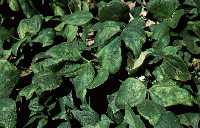 |
Figure 1: Initial halo blight symptoms. |
Figure 2: Foliar halo blight symptoms. |
 |
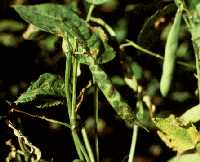 |
Figure 3: Young brown spot lesions. |
Figure 4: Brown spot lesions on pods. |
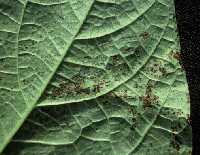 |
 |
Figure 5: Common bacterial blight. |
Figure 6: Mature common blight lesions. |
Disease Symptoms
Halo blight symptoms on leaves initially appear as greasy, water-soaked spots about 1/16 inch in diameter. They are generally most visible on the underside of young leaflets approximately one week after infection. One or more water-soaked spots are later surrounded by a greenish-yellow halo about 1/16 to 1/2 inch in diameter. This halo is caused by a bacterial toxin. The size and development of this halo is variable, and may not be produced during high temperatures. During severe infection, the disease may become systemic and cause yellowing and death of new foliage. Halo blight symptoms on pods appear as small circular, water-soaked spots or streaks. A light cream or silver-colored bacterial ooze is often associated with these spots. Pod infection often causes discoloration, shriveling and bacterial contamination of seeds; however, some seed may appear to be healthy.
Bacterial brown spot symptoms are similar to young halo blight lesions after initial infection. The symptoms appear as small water-soaked spots most visible on the underside of young foliage. A narrow, greenish yellow border about 1/16 inch wide may surround some of the lesions. However, when the lesion matures, it typically develops a “brown spot” appearance, and dead tissue in the center may fall out, producing a shot-hole appearance. Infected pods may be twisted and kinked and exhibit circular brownish water-soaked spots.
Common bacterial blight symptoms exhibit a scalded appearance on leaf tissue and contain water-soaked spots. These small, irregularly shaped lesions often enlarge to greater than 1 inch or more and form dark brown lesions along the edge of the leaflet. A narrow lemon-yellow margin often surrounds these lesions and large portions of the foliage can be infected. Infected pods exhibit circular, water-soaked areas that often produce yellow masses of bacterial ooze. Later, spots dry and appear as reddish-brown lesions. Pod infection often causes discoloration, shriveling and bacterial contamination of seeds; however, some seed may appear healthy.
Bacterial wilt symptoms may appear after plugging of the water-conducting tissue of young seedlings which may wilt and die. Leaves of older infected plants will wilt, especially during moisture stress and warmer parts of the day. Golden brown, irregularly-shaped leaf lesions occur, with or without evidence of water-soaking, and affected leaves wilt and may drop off. Infection can occur on pod sutures similar to that caused by other bacterial diseases, but seldom will it produce circular water-soaked spots. The bacterium may cause a seed discoloration (yellow, orange, purple), depending on the strain of wilt organism and bean market class
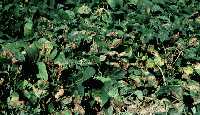 |
Figure 7: Foliar common blight symptoms. |

Figure 8: Foliar bacterial wilt symptoms. |
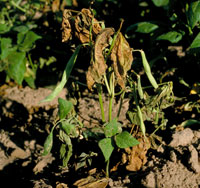
Figure 9: Foliar bacterial wilt symptoms and wilt. |
Disease Management
Bacterial pathogens of dry and snap beans can be managed, but not eliminated, by carefully implementing integrated crop production strategies. These approaches reduce or delay disease severity during the critical periods of vegetative and reproductive plant growth. This section summarizes commonly suggested disease management strategies.
Overwintering populations can effectively be reduced by employing a three- to four-year rotation with beans planted once every third or fourth year. Corn, small grains and vegetables are recommended crop alternatives during two of these years. Proper sanitation of bean crop debris is important. It requires the complete incorporation of straw into the soil and the elimination of volunteer beans early the following year. This reduces diseased plants which provide the inoculum responsible for disease outbreaks in nearby bean fields. Bacterial pathogens can also survive in bean dust on contaminated harvest equipment, seed-cleaning equipment and storage containers.
Always plant high quality certified seed to minimize early season disease. Treat seeds with streptomycin, which effectively kills most external bacterial contamination. Diseases can still develop in these fields, but the pathogens must be transported into the field from external inoculum sources.
Avoid cultivation of beans when plants are wet or when the stand is too tall to allow machinery to pass through without wounding the foliage. Thoroughly clean soil, weeds and crop residues from equipment before moving to other fields. Reuse of irrigation runoff water is not recommended since pathogens are transmitted by it. Sprinkler irrigation can increase the spread and severity of bacterial foliar diseases by splashing bacteria from plant to plant, and extending leaf wetness periods.
Planting resistant varieties is the best method to manage bacterial diseases of beans. Most older bean varieties, especially pintos and light red kidneys, are susceptible to these bacterial diseases. Fortunately, blight resistant varieties are available in other market classes. Most navy and small white varieties, including Aurora, are resistant to halo blight. Consult your local Colorado State University Extension and bean industry personnel regarding new resistant varieties for your area.
In Colorado, copper-based bactericides have effectively reduced populations of pathogenic pseudomonads on bean foliage and reduced the spread of these pathogens in infected Crops. Common bacterial blight and bacterial wilt are not controlled as effectively by copper spray programs, although some reduction in disease may be obtained with a preventive program. Applying these protectants early in the season (June to July) every seven to 10 days during cool to warm, moist weather can decrease establishment of bacterial pathogens.
To ensure complete coverage, these products should be applied with at least 5 gallons of water per acre. When pathogens have become established and disease symptoms are evident, copper sprays can help reduce their spread to healthy foliage and pods. But bacteria inside lesions are not affected. Commonly used cupric hydroxide bactericides include Kocide, NuCop and Champ. Always read the product label carefully and consult extension and industry representatives for updated recommendations.
Closely inspect bean fields for symptoms of bacterial diseases throughout the growing season, especially after prolonged periods of high humidity. Apply a bactericide every seven to 10 days until plants are within 2 to 3 weeks from harvest; continue protection if infection is detected and weather conditions remain favorable for disease development. Hail-damaged beans should receive a preventive application of a copper bactericide to protect damaged plants during regrowth.
It must be emphasized that to minimize the impact of bacterial diseases on bean Crops in our region the producer must carefully integrate recommended strategies of crop rotation, sanitation, use of treated certified seed, varietal selection, stress and wound avoidance, and proper pesticide scheduling.
*Colorado State University Extension plant pathologist and professor, bioagricultural sciences and pest management. 9/99. Portions extracted from the regional extension publication 562A, Dry Bean Production and Pest Management, by H.F. Schwartz, M.A. Brick, R.M. Harveson and G.D. Franc. Acknowledgement is given for support from the Colorado Seed Growers Association and Colorado Dry Bean Administrative Committee. Revised 5/11.
Go to top of this page.





